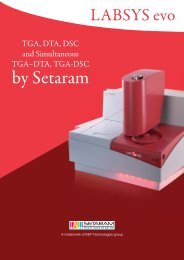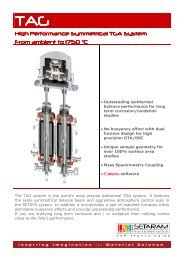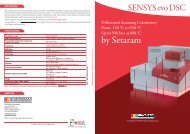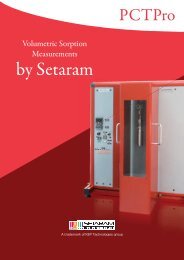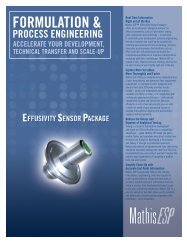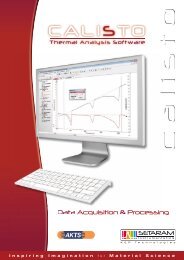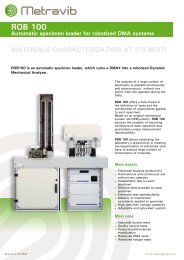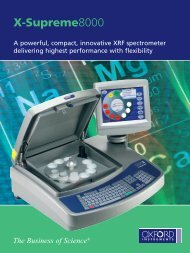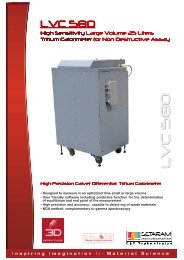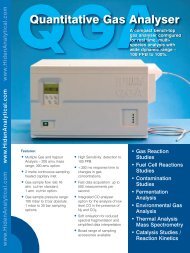Download Brochure: 96 line - EXPERTA
Download Brochure: 96 line - EXPERTA
Download Brochure: 96 line - EXPERTA
You also want an ePaper? Increase the reach of your titles
YUMPU automatically turns print PDFs into web optimized ePapers that Google loves.
<strong>96</strong> Line<br />
A modular <strong>line</strong> of high temperature -<br />
high volume thermal analyzers<br />
KEP<br />
TECHNOLOGIES
<strong>96</strong> Line<br />
A modular <strong>line</strong> of high temperature -<br />
high volume thermal analyzers<br />
<strong>96</strong> Line thermal analyzers can be distinguished<br />
by the following characteristics:<br />
• Multi-modularity<br />
All the analyzers of <strong>96</strong> Line, DTA, DSC, MHTC (calorimetry<br />
and DSC), TGA and TMA, are designed<br />
to adapt to the same structure (furnace, electronics,<br />
gas circuits, atmosphere control). This<br />
configuration enables economic testing of samples<br />
with different thermal analysis techniques.<br />
• High temperature<br />
The furnace is based on graphite resistor technology,<br />
which provides safety during operations at<br />
high temperatures. It covers a range from ambient<br />
temperature to 2,100°C, with regulation adapted<br />
to different temperature ranges. The furnace has a<br />
large zone of homogeneous temperature.<br />
• Large sample volume<br />
Thanks to the furnace's large diameter, the sensors<br />
developed for DTA, DSC, MHTC, TGA and<br />
TMA measurements can accommodate large samples.<br />
For all thermal analysis techniques, the fact<br />
of being able to use a large sample volume has<br />
many advantages and provides possibilities such<br />
as:<br />
- Analysing bulky, massive and non-dissociable<br />
samples (e.g. corrosion studies of mechanical<br />
parts, etc.)<br />
Module used<br />
Max. sample volume<br />
V (µl) 0 (mm) H (mm)<br />
DTA 500 6,5 16<br />
DSC 420 7 11<br />
MHTC hf-dsc 450 6 16<br />
MHTC drop 5700 14,5 35<br />
TGA 18100 21,5 50<br />
TMA 18 (15 50<br />
recommended)<br />
Temperature<br />
range<br />
(°C)<br />
Heating<br />
element<br />
Temperature<br />
control<br />
thermocouple<br />
Amb/1600 Amb/1750 Amb/2100<br />
Graphite Graphite Graphite<br />
Type S Type B Type W5<br />
- Working on mixed materials (concrete core sample,<br />
etc.)<br />
- Detecting very weak variations of mass in TGA<br />
(corrosion studies on sheet steel, etc.)<br />
• Varied and controlled atmospheres<br />
The atmosphere control device is designed to permit scanning different gases (inert and reactive) during<br />
analysis with precision control of their flows in particular so as not to disturb thermogravimetric measurements.<br />
The chamber is built to withstand high vacuums before and during analysis. The different operations<br />
of introducing gases, creating a vacuum and switching gases during analysis can be fully automated and<br />
controlled from a computer.<br />
2
Principle diagram (TGA <strong>96</strong> model)<br />
Balance beam<br />
Carrier gas<br />
Auxiliary gas<br />
Furnace<br />
protective<br />
gas<br />
Alumina tube<br />
Sample<br />
Temperature<br />
control thermocouple<br />
Graphite heating<br />
element<br />
Graphite felt sleeve<br />
Cooling water<br />
Purge, primary vacuum<br />
3
MHTC <strong>96</strong><br />
For calorimetric measurements<br />
and DSC<br />
Experimental constraints from one experiment sometimes contradict each other, i.e. low sample<br />
mass for good transition detection, high sample mass for accurate determination of heat<br />
capacity, analysis at constant and variable temperatures, use of the crucible open or closed.<br />
Two types of sensor have been developed to meet these different needs.<br />
MHTC <strong>96</strong> hf-dsc<br />
Two ceramic chambers (one measurement and one reference), arranged vertically, side by side, are linked<br />
together by two conducting plates with 20 thermocouples. The differential detector thus formed completely<br />
envelopes the experiment chamber (the sensor uses the "quasi-Calvet" principle), thereby providing global<br />
and precise measurements.<br />
Two sensors are available according to the temperature range used:<br />
- MHTC <strong>96</strong> hf-dsc ambient / 1400°C: S type thermocouple<br />
- MHTC <strong>96</strong> hf-dsc ambient / 1600°C: B type thermocouple<br />
Applications<br />
• Study of structural transformations in metals and alloys, minerals, oxides;<br />
• Formulation of equilibrium diagrams,<br />
• Study of material reactivity at high temperatures,<br />
• Determination of heat capacity Cp according to the continuous or incremental method.<br />
MHTC <strong>96</strong><br />
hf-dsc<br />
sensor<br />
MHTC <strong>96</strong><br />
hf-dsc<br />
Amb / 1400° C<br />
Amb / 1600° C<br />
drop<br />
Amb / 1300° C<br />
Amb / 1500° C<br />
Type of<br />
crucible<br />
Alumina 450 6 16<br />
PtRh10% 450 6 16<br />
(+alumina<br />
lining)<br />
Max. sample size<br />
V(µl) O (mm) H (mm)<br />
300 5 15,5<br />
PtRh10% 5000 13,5 35<br />
Alumina 5700 14,5 35<br />
Section of<br />
the MHTC <strong>96</strong><br />
hf-dsc sensor<br />
Crucible<br />
Thermopile<br />
Alumina tube<br />
Heating<br />
element<br />
MHTC <strong>96</strong> drop<br />
The calorimetric sensor is symmetrical and designed to contain 2 crucibles arranged one below the other.<br />
The lower crucible is used for the reference and holds an inert material to offset the heat capacity of the<br />
sample contained in the upper crucible.<br />
A thermopile composed of a chain of 28+28 thermocouples connected in series covers the surface of the<br />
measurement and reference crucibles.<br />
Two sensors are available depending on the temperature range used:<br />
- MHTC <strong>96</strong> drop ambient / 1300°C: S type thermocouple<br />
- MHTC <strong>96</strong> drop ambient / 1500°C: B type thermocouple<br />
Applications:<br />
• In isotherm mode, it is especially used for the drop calorimetric method to determine the specific heat of very different<br />
materials, the heat of solution of metals in metal baths (alloy formation), oxides in oxide baths (complex oxide formation),<br />
calculation of thermal balances, etc.<br />
• In programmed mode, it is DSC mode for large samples. The applications are analogous with those of the DSC sensor.<br />
MHTC <strong>96</strong><br />
drop<br />
sensor<br />
4
DTA <strong>96</strong>, DSC <strong>96</strong><br />
Tri-couple DTA sensors<br />
The excellent symmetry of the detectors, each composed of three thermocouples, guarantees<br />
very good base <strong>line</strong> stability and a very high detection threshold for thermal measurement.<br />
The alumina crown surrounding the detector guarantees accurate and reproducible positioning<br />
of the crucible.<br />
Two types of DTA rod are available for the <strong>96</strong> Line:<br />
- Ambient to 1600°C: S type thermocouple<br />
- Ambient to 1750°C: B type thermocouple<br />
DTA<br />
rod<br />
High temperature DTA sensor<br />
High temperature measurements require the use of tungsten-rhenium thermocouples. This high temperature<br />
DTA is composed of a tungsten base plate with two machined housings for the measurement and<br />
reference crucibles and tungsten-rhenium thermocouples that also ensure good rod rigidity.<br />
- Ambient to 2100°C: W5 type thermocouple<br />
High<br />
temperature<br />
DTA<br />
rod<br />
DSC sensor<br />
The characteristics of plate type DSC sensors are good quantitative measurement of thermal effects and<br />
low variation of sensitivity vis-à-vis the measurement temperature.<br />
Composed of a metal support with two housings for the crucibles, the sensor provides good thermal<br />
contact between the crucible and the detector. Two plate DSC rods are available for <strong>96</strong> Line:<br />
- Ambient to 1500°C: S type thermocouple<br />
- Ambient to 1600°C: B type thermocouple<br />
DSC<br />
rod<br />
Applications :<br />
• Detection of phase transformations, heat capacity measurement<br />
• Study of small samples<br />
• Utilization of faster heating rate (up to 20°C.min- 1 )<br />
<strong>96</strong> Line sensor<br />
DTA<br />
Amb / 1600° C<br />
Amb / 1750° C<br />
Amb / 2100° C<br />
DSC plate<br />
Amb / 1500° C<br />
Amb / 1600° C<br />
Type of<br />
crucible<br />
Max. sample volume<br />
V (µl) O (mm) H (mm)<br />
PtRh 10 % 500 6,5 16<br />
Alumina 250 3,8 20<br />
Carbon,<br />
tungsten<br />
220 5,5 9,5<br />
PtRh 10 % 420 7 11<br />
Alumina 360 6,5 11<br />
5
TGA <strong>96</strong><br />
This is an extremely high performance weighing module used with the TGA <strong>96</strong>. This balance can weigh samples<br />
up to 100 g and are well adapted to measuring both micro-quantities of samples (a few milligrams) and<br />
large and dense samples, while maintaining measurement resolution to within a microgram whatever the<br />
mass analyzed.<br />
Three temperature versions of the TGA <strong>96</strong> are available according to the regulation used:<br />
- Ambient to 1600°C: S type regulation thermocouple<br />
- Ambient to 1750°C: B type regulation thermocouple<br />
- Ambient to 2100°C: W5 type regulation thermocouple<br />
Crucibles adapted to different applications<br />
Several configurations are possible to analyze samples with the TGA <strong>96</strong>:<br />
• The sample is placed in a crucible suspended from the balance by an<br />
adapted suspension system. Several types of crucible are available for TG<br />
measurements.<br />
• The sample can also be suspended directly from the balance without<br />
being placed in a crucible beforehand. Maximum dimensions of the<br />
crucible are length: 80mm, height: 20 mm.<br />
• The sample can be placed in a TGA rod with a built-in thermocouple in<br />
order to measure its temperature.<br />
TGA <strong>96</strong><br />
Amb / 1600° C<br />
Amb / 1750° C<br />
Amb / 2100° C<br />
Type of<br />
crucible<br />
Without crucible 20 80<br />
PtRh10% 18100 21,5 50<br />
PtRh10%<br />
grid<br />
15700 20 50<br />
Alumina 17300 21 50<br />
Graphite 14900 19,5 50<br />
Alimina<br />
crucible with<br />
TGA rod<br />
Simultaneous TGA-DTA/DSC measurements<br />
The DTA and DSC rods presented on the previous page can be suspended<br />
from the balance. Thus, TG signal measurement (gain or loss of sample<br />
mass) is obtained at the same time as the DTA or DSC signal measurement<br />
(according to the rod used), providing qualitative and quantitative<br />
data on the thermal exchange of the sample.<br />
Simultaneous TGA-DTA<br />
- Ambient to 1600°C<br />
- Ambient to 1750°C<br />
- Ambient to 2100°C<br />
Max. sample volume<br />
V(µl) O (mm) H (mm)<br />
2000 9,8 26<br />
Simultaneous TGA-DSC<br />
- Ambient to 1500°C<br />
- Ambient to 1600°C<br />
DTA and DSC rods designed for measuring small sample quantities<br />
(typically 100 µl) can also be used with the TGA <strong>96</strong>.<br />
A wide range of measurement<br />
possibilities:<br />
In addition to the TGA <strong>96</strong>, SETARAM<br />
proposes different accessories and<br />
software that permit in particular:<br />
- TGA measurements in corrosive<br />
atmospheres,<br />
- Controlled rate TGA measurement<br />
(CRTA: controlled rate thermal<br />
analysis)<br />
- Coupling with a gas analyzer either<br />
FTIR or mass spectrometry type. A<br />
special coupling part is installed at<br />
the furnace outlet and serves as<br />
interface between the TGA <strong>96</strong> and<br />
the gas analyzer.<br />
6
TMA <strong>96</strong><br />
Vertical dilatometry<br />
The TMA <strong>96</strong> has a vertical configuration that<br />
permits working under very low loads (from<br />
2 g) without subjecting the sample to effort.<br />
The displacement sensor of the TMA <strong>96</strong> is<br />
both robust and highly accurate. It detects variations<br />
of displacement as low as 0.01<br />
micron. The sensor of the TMA <strong>96</strong> uses an electromagnetic<br />
system allowing automatic<br />
control of force on the sample up to 1.5 N.<br />
This force can be increased by adding weight<br />
(up to 200 grams) on the upper plate. The<br />
computer manages calibration adjustment<br />
and force control automatically.<br />
Loading plate<br />
Movable coil<br />
Magnet<br />
Core of the transformer<br />
Differential transformer<br />
Probe adjustment<br />
Probe fixation<br />
Sample holder<br />
Three temperature versions are available according to<br />
the regulation used:<br />
- Ambient to 1600°C: S type regulation thermocouple<br />
- Ambient to 1750°C: B type regulation thermocouple<br />
- Ambient to 2100°C: W5 type regulation thermocouple<br />
Probe<br />
Adapted probes<br />
The TMA <strong>96</strong> is used with "spherical end compression"<br />
type probes.<br />
The probes are made of alumina for ambient temperature<br />
to 1750 °C, whereas graphite probes are used<br />
above 1750°C.<br />
Sample<br />
Temperature<br />
control thermocouple<br />
Alumina tube<br />
TMA<br />
Type of probe<br />
Max. sample volume<br />
O (mm)<br />
H (mm)<br />
Amb / 1600° C<br />
Amb / 1750° C<br />
Alumina<br />
18 (15<br />
recommended)<br />
50<br />
Amb / 2100° C<br />
Graphite<br />
18 (15<br />
recommended)<br />
50<br />
7
<strong>96</strong> Line<br />
Technical characteristics<br />
LIGNE <strong>96</strong><br />
DTA <strong>96</strong><br />
DSC <strong>96</strong><br />
MHTC <strong>96</strong><br />
hf-DSC<br />
MHTC <strong>96</strong><br />
drop<br />
TGA<br />
TMA<br />
Temperature range<br />
of measurement<br />
module<br />
(°C)<br />
amb / 1600<br />
amb / 1750<br />
amb / 2100<br />
amb / 1500<br />
amb / 1600<br />
amb / 1400<br />
amb / 1600<br />
amb / 1300<br />
amb / 1500<br />
amb / 1600<br />
amb / 1750<br />
amb / 2100<br />
amb / 1600<br />
amb / 1750<br />
amb / 2100<br />
Volume of crucible<br />
(µl)<br />
220 / 550<br />
360 /420<br />
300 / 450<br />
5000 / 5700<br />
18000<br />
/<br />
Max.<br />
sample size<br />
(mm)<br />
/<br />
/<br />
/<br />
/<br />
/<br />
L=50 D:18<br />
(15<br />
recommended)<br />
Resolution<br />
/<br />
5 µW<br />
7 µW<br />
8 µW<br />
0,3 µg<br />
1,6 nm<br />
RMS noise<br />
/<br />
66 µW<br />
83 µW<br />
330 µW<br />
0,3 µg<br />
10 nm<br />
Specific RMS<br />
noise<br />
/<br />
0.16 µW/µl<br />
0.18 µW/µl<br />
0.05 µW/µl<br />
0.016 µg/ml<br />
0.2 . 10 -6<br />
Measurement<br />
range<br />
/<br />
/<br />
/<br />
/<br />
+/- 2000 mg<br />
+/- 6 mm<br />
The <strong>96</strong> Line is equipped with SETSOFT 2000, the thermal analysis software from SETARAM<br />
SETARAM Inc.<br />
Suite 116 - 130 Gaither Drive<br />
Mt. LAUREL NJ 08054 - USA<br />
Tél. +1 856 778 7600<br />
Fax +1 856 778 7377<br />
KEP<br />
TECHNOLOGIES<br />
Excellence in thermal analisys and calorimetry.<br />
email: sales@setaram.com - http://www.setaram.com<br />
Head office<br />
SETARAM S.A. France<br />
7, rue de l’Oratoire<br />
F-69300 CALUIRE - France<br />
Tél. +33 (0)4 72 10 25 25<br />
Fax +33 (0)4 78 28 63 55<br />
SETARAM Techn. Buro Deutschland<br />
Postfach 1426<br />
D-09584 FREIBERG - Deutschland<br />
Tél. +49 (0)3731 356641<br />
Fax +49 (0)3731 356642<br />
Technical specifications are given as indications only and are not contractual.<br />
SETARAM - RCS 775 648 744 / Compte-Fils Communications - 11/02 - Photos : SETARAM<br />
8, rue du Mouzon - B.P. 1085<br />
54523 LAXOU CEDEX - FRANCE<br />
Tél. +33 (0)3 83 97 20 10<br />
Fax +33 (0)3 83 98 70 75<br />
2, rue Jacques Duclos - Z.I. des Dames<br />
78346 LES CLAYES-SOUS-BOIS CEDEX - FRANCE<br />
Tél. +33 (0)1 30 07 77 30<br />
Fax +33 (0)1 34 81 28 45


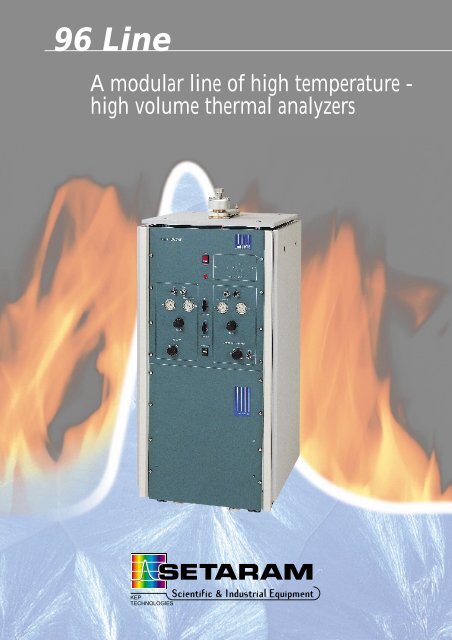
![LVC-3013-2012 [Mode de compatibilité] - EXPERTA](https://img.yumpu.com/47900153/1/184x260/lvc-3013-2012-mode-de-compatibilitac-experta.jpg?quality=85)
